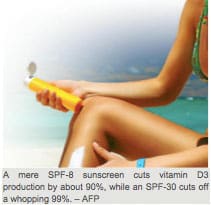FACT OR MYTH 1: I GET PLENTY OF VITAMIN D FROM SUNLIGHT BECAUSE I LIVE IN SUNNY MALAYSIA.

Myth. Living in tropical Malaysia does not mean we are getting enough of the sunshine nutrient, vitamin D3. Factors affecting vitamin D production from sunlight range from the angle of the sun’s rays, the time of the day, skin type, etc.
According to the US-based Vitamin D Council, a non-profit organisation responsible for spreading reliable information on vitamin D, vitamin D deficiency is estimated to affect up to 50% of the adult population worldwide.
Most white collar workers (i.e. professionals, managers, administrative staff) suffer in this aspect, as they spend all day in their offices.
Although our skin makes vitamin D3 when exposed to the sun, ageing makes the skin less productive. The problem is made worse by older people spending more time indoors.
Another interesting fact is that a mere SPF-8 sunscreen cuts vitamin D3 production by about 90%, while an SPF-30 cuts off a whopping 99%.
What would be advisable is to wear a wide-brimmed hat and a pair of sunglasses to cover your face, while exposing as much of your body as possible to the sun for at least 15-20 minutes between 10am and 2pm two to three times a week to ensure maximum production of vitamin D3.
If you are unable to do this, it is then advisable to take vitamin D3 supplements.
FACT OR MYTH 2: I GET SUFFICIENT AMOUNT OF VITAMIN D FROM MY DIET.
Myth. According to American translational physician-scientist Dr Michael F. Holick, it is virtually impossible to obtain an adequate amount of vitamin D from our diet. He notes that more fortified food and beverages are likely to emerge on the market to fill the gap.
Few foods are naturally rich in vitamin D, so the main dietary sources of vitamin D are fortified foods. Good sources include fortified milk and breakfast cereals. However, if you check the nutritional facts on our local milk cartons, you will find that only one to two brands contain vitamin D.
Natural sources of vitamin D include fatty fish such as salmon and tuna, canned sardines and mackerel with smaller amounts in egg yolks and certain mushrooms.
FACT OR MYTH 3: VITAMIN D CAN STRENGTHEN THE IMMUNE SYSTEM AND HELP WARD OFF CANCER.
Fact. Researchers now confirm that our immune cells have receptors for vitamin D, which means that it is needed at optimal levels for the immune system to function well. Deficiency in vitamin D is associated with increased autoimmunity and an increased susceptibility to infection. Vitamin D deficiency has also been linked to 18 types of cancer.
Japanese researchers reported that daily supplementation of vitamin D3 reduces the risk of getting influenza A by over 40%. Another study found that people who maintained normal or optimal levels of vitamin D levels developed fewer viral infections, including influenza, and were sick for fewer days than participants with lower levels of vitamin D (PloSONE, June 14, 2010).
Vitamin D may help boost the immune system, according to new research (Mac, 2013) from Boston University School of Medicine. The study published online in the Public Library of Science journal PLOS ONE, found raising levels of vitamin D in the blood markedly impacts genes linked to the development of cancer, cardiovascular disease, infectious diseases, and autoimmune diseases.
Dr Holick has noted that previous studies have shown that vitamin D deficiency is associated with an increased risk for many of these diseases, but the new research goes a step further and provides direct evidence that boosting the “sunshine vitamin” plays a big role in improving immunity and lowering the risk for many conditions.
FACT OR MYTH 4: NOT ALL VITAMIN D SUPPLEMENTS ARE EQUAL.
Fact. Two forms of vitamin D are used in supplements: vitamin D2 (ergocalciferol) and vitamin D3 (“cholecalciferol”). Vitamin D3 is the type of vitamin D the body naturally produces in the skin in response to sun exposure. Vitamin D2 is produced naturally when fungi (yeast or mushrooms) are exposed to ultraviolet light from the sun or to artificial UV light.
Regardless of which form you use, your body must convert it into an active form, and vitamin D3 is converted five times faster than vitamin D2.
FACT OR MYTH 5: VITAMIN D IS FAT SOLUBLE AND CAN EASILY CAUSE TOXICITY.
Myth. The safety limit is much higher than commonly believed. Based on the latest evidence, it is determined that 10,000 I.U. a day is non-toxic. After all, your body can easily make 20,000 I.U. after 30 minutes at the beach between 10am and 2pm.
Published cases of toxicity, for which serum levels and doses are known, all involve intake of over 40,000 IU (1,000mcg) per day. Many health experts recommend 1,000 I.U. to 2,000 I.U. of vitamin D3 supplements a day.
The Institute of Medicine was able to set a recommended daily allowance (RDA) for vitamin D in 2010. The RDA for children and adults up through age 70 is 600 International Units (IU) per day. The RDA is 800 IU a day for adults older than 70. The safe upper limit for adults was set at 4,000 IU per day.

